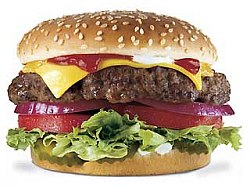Hungry for More: How to Manage Post-Workout Cravings
The Food-Exercise Equation
Two days ago I logged my usual 12 laps around the local track. I finished hungry but happy. When I popped over there today, I found the track gone, razed by bulldozers now sitting atop a huge pile of mud. How was I supposed to lose weight if I had no place to exercise?
Actually, skipping my workout might not be a bad thing, according to a hotly contested idea circulating among researchers and making headlines in publications such as The New York Times and Time magazine. Exercise, ironically, is being singled out by some as a deterrent to weight-loss efforts. Say what?
"There's this hunger issue," says Kendrin Sonneville, RD, a researcher at the Harvard School of Public Health. Her study about how kids who exercised the most ate back all the calories they burned off, and then some, was featured in a Time cover story, "Why Exercise Won't Make You Thin," last fall. "After the article came out, my sister called me and asked, 'So, is exercise a waste of time?' " Sonneville's reply: "No, but it's not a panacea for weight-loss either, because it does increase your appetite. The food-exercise equation is imbalanced. It may take an hour to burn 500 calories but only five minutes to eat them back."
And that's exactly what your body wants you to do. "In the short term, during or right after a workout, exercise may suppress hunger," says Barry Braun, PhD, professor of kinesiology and director of the Energy Metabolism Laboratory at the University of Massachusetts in Amherst. "But later that day, your hunger hormones can surge, making you want to eat. At the same time, your body's satiety hormones — the ones that signal that you're full — may decrease." The really unfair part, Braun notes, is that the desire to eat more after exercising hits women harder than men. "When we look at blood samples of people starting an exercise program, there is a subtle change in men's hormone levels, but for women, exercise really elevates the hormone that increases appetite," he says. "The widely accepted theory is that women's bodies are hardwired to hold onto energy for reproduction purposes." So when your body senses that you're burning fuel from exercise, it wants to be sure you replace it pronto.
All of which means that for women who love fitness and want to be toned as well as trim, shedding pounds poses a unique challenge. But the payoff is well worth it: "What all the latest news stories missed is the role exercise plays in keeping the pounds off in the long run," says Timothy Church, MD, PhD, a professor at the Pennington Biomedical Research Center in Baton Rouge, Louisiana, who has done extensive research on the factors that influence successful weight loss. "It's a fact that the only people who keep off the weight they've lost are the ones who are physically active." Those who use dieting alone to drop pounds usually find themselves right back where they started or even heavier, studies show. Beyond slimming you down, exercise offers other major benefits: It blasts dangerous belly fat; reduces your risk of high cholesterol, heart disease, and diabetes; and makes you happy — each of which can help you live longer.
Understanding Your Hunger
The key to sticking with your workout and diet while dodging stomach rumblings and cravings is to understand the relationship between energy (food) and exercise and to learn to use it to your advantage. The first step is decoding where the hunger is coming from.
Happy Hunger
If you like to celebrate the end of a tough workout with a treat (Vanilla cone with rainbow sprinkles? Yes, please!), listen up. "I have many clients who think if they work out, they can reward themselves by eating whatever they want," says Dawn Jackson Blatner, RD, author of The Flexitarian Diet and a FITNESS advisory board member. That approach can backfire. "My advice is to eat back no more than half the calories you burn off during a workout. So if you burn 300 calories jogging, you have 150 calories to play with afterward." The trick is to maximize your nutritional intake in minimal calories. Rather than use those 150 calories on a vitamin drink — the wrong move, because liquid calories won't satisfy your hunger — a better option would be to "spend those calories on healthy, filling foods, such as a sliced apple with peanut butter, to maximize satiety," Blatner says.
Fear Hunger
On the other end of the spectrum, some women are afraid to consume calories before their sweat session, figuring they'll negate the purpose of 60 minutes on the elliptical. But working out on an empty stomach means that you won't have the energy to exercise as long or as hard, so you'll end up burning fewer calories than if you had amped up your stamina with a 200-calorie pre-workout snack and pushed your way through a tough session, says Leslie Bonci, RD, director of sports nutrition at the University of Pittsburgh Medical Center and a FITNESS advisory board member. "Eating something, such as a piece of fruit, before exercise may give you more energy to get through a workout," Blatner says.
Rebellion Hunger
Leaving your fuel supply depleted post-workout is similarly shortsighted. Eventually you will get hungry — and crave fatty food. "When we're starving, our body wants to consume energy-dense food as quickly as possible," Sonneville says. So instead of spending 150 calories after the gym on a low-fat yogurt, you end up scarfing down two 600-calorie brownies a couple of hours later.
The Importance of Staying Hydrated
But what if you eat a healthy snack after you exercise and an hour later you're hungry again? Your signals may be getting crossed with another sensation entirely. "Even the top athletes I advise need to pay more attention to hydration," Blatner says. "Most people don't drink enough before, during, and after their workout." The brain confuses a lack of liquid with not enough food, triggering hunger pains. To help yourself hydrate properly, when you grab your post-workout string cheese and fruit (or protein bar), guzzle water with them to help fill you up. As a rule of thumb, drink eight ounces of water before snacking to be sure you're truly hungry, not thirsty.
Properly hydrated, you should be able to get through an hour-long workout without breaking for food. But for cardio sessions lasting longer than 60 minutes, you may also need an extra jolt of fuel during your activity. "If I run more than an hour, I know I'm going to be really hungry the rest of the day and want to eat like a pig," Dr. Church says. His quick fix: Take a few bites of an energy bar along the trail. On your big exercise days — a 90-minute weekend run or a three-hour mountain bike ride — you'll need to fuel up differently than you would on a typical treadmill day. Carb-rich calories are what your body craves as your store of glycogen is depleted during endurance events. In general, aim for 100 calories of carbs and electrolytes for every additional half hour of exercise after your first hour of working out. "This is what sports drinks were designed for," Braun says. "A banana with water would have the same effect, but it's just not as convenient." Other options include dried fruit, energy gels, and jelly beans, which can quickly be converted from food to fuel for your muscles. For maximum benefits, stay well hydrated for the first 60 minutes. Then if you are still working out, take in carb calories and electrolytes, both of which are found in sports drinks.
Your All-Day Diet Plan
The biggest piece of the hunger puzzle is knowing what, when, and how much to eat to stoke your body's engine 24-7. It's the peaks and dips in energy levels, set off by inconsistent eating habits, that send cravings into overdrive. To keep things on track, follow this around-the-clock advice.
In the morning...
Make your digestive system work. "If you put sugary cereal in your mouth, it literally dissolves. With shredded wheat, you have to work to chew it," says Sonneville. "The same thing happens in your stomach; it has to churn away to digest high-fiber foods, making you feel fuller longer." Aim for 25 grams of fiber a day.
At lunch...
Be a meal splitter. If your good intentions in attending that noontime boot-camp class are regularly squandered because you're too hungry to push yourself through it, give your efforts an extra edge by eating lunch twice — half at 11 a.m., the other half when you get back from the gym. Look for a mix of three carbs to one protein; banana and peanut butter on whole wheat is a good option. Have half the sandwich an hour before you exercise, the other half immediately after your workout. You'll be amazed at how much more energy you have during your session, without the hunger pangs afterward.
For a snack...
Do the apple test. "Ask yourself, 'Does eating an apple sound good right now?'" Blatner says. An apple is a stomach-filling food, so if it is appealing, you probably are hungry and should break for a healthy snack. If an apple isn't calling your name, you may be turning to food for other reasons, like boredom or stress. Drink water instead.
At night...
Turn in earlier. A recent study found that participants ate significantly more calories from sugary carbs after five and a half hours of slumber than they did after eight and a half hours. Experts aren't sure why, but some suspect that less sleep causes ghrelin, the appetite-stimulating hormone, to spike. You already know that more sleep equals a better workout, so hit the sack an hour earlier tonight.
Ultimately you've got to approach hunger the way you do your workout: methodically and consistently. "People who manage hunger well are those who eat mindfully," Sonneville says. "You do yourself a disservice if you just count calories. You've got to pay attention to how you feel and how your workout is being affected, too." Don't snack excessively before or after exercise; many active people don't need additional calories to fuel their daily 30 to 45 minutes. Hydrate during your workout, and when you feel hungry, drink water first. At mealtimes, eat slowly, and with every few bites, ask yourself if you feel full. "After a while, you may not even be tasting or enjoying the food. Many people just eat until the food is gone," Sonneville notes. "Pay attention to your body's cues." And remember, if your workout makes you hungry, don't skip the gym so you can stick to your diet. A small increase in calories before exercising will power you through your cardio session and reap you far greater rewards than no workout at all.
Solutions to Your Common Diet Dilemmas
FITNESS advisory board member Dawn Jackson Blatner, RD, solves your diet and workout dilemmas.
I exercise in the morning — no time for a full breakfast. What should I do?
Eat a cup of sliced fruit before you head out and have a serving of high-fiber cereal, such as Kashi GoLean, with a cup of low-fat milk when you get back. This 400-calorie breakfast has the right mix of carbs and protein to help you through your morning.
I'm good all morning. Then I scarf down pizza at lunch.
A midmorning snack will keep your hunger in check so that you don't blow your diet at noontime. Go for produce and protein: an apple with a handful of almonds or a pear with string cheese.
After working out, I'm starving. What can I eat without packing on pounds?
Healthy dairy options, like low-fat yogurt, are great after exercise: The protein in them works to repair muscles, and their carbs replenish energy. Assuming you burn about 300 calories during a 30-minute workout, the 150 calories in a yogurt are the right amount to eat back and still lose weight.
Log Your Workouts and Meals
How many calories are you really burning during your workout? Keep a tally for just a week to gain some perspective.
-
Convenient exercises you can do at home [video]
-
Lighten Your Body And Enjoy Your Life
Patience is a virtue in weight control. Forget about the strictness a
-
Why Low Carb Diets May Be Counterproductive
There are many different kinds of diets on the market, they all
-
Putting Definition in Your Leg Muscles
Some people are simply born with well-defined leg muscles ? and
-
Great Steps On How To Prevent The Loss Of Hair
Dealing with the loss of hair is often difficult, but you can fee
-
Good-for-You Holiday Desserts
Cookies. Candy. Cake. The holidays can be one big fat trap. But before
- DON'T MISS
- Want To Lose Weight Quicky? See These Tips For Quick Weight Loss
- 10 Walking Mistakes Youre Makingvar zeus = zeus
- 6 Biggest Lies About Weight Loss
- Tip On How To Lose Weight Fast
- Weight Loss Strategies That Will Work For You
- How to Lose Weight Fast (For Women)
- Weight loss Tip #50 – Follow the red, green and orange food rule for weight loss
- 8 Smoothie Add-Ins That Rev Your Metabolism and Help You Lose Weight
- Weight Loss Tips - Working Adults Have No Time
- A New Prostate Cancer Risk Factor




